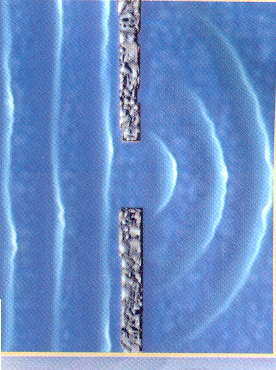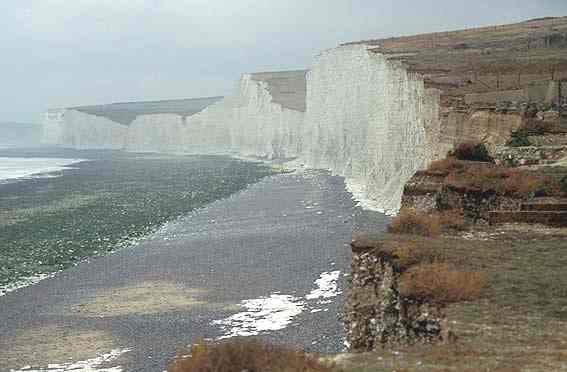PEMBAHASAN
Tembok laut beton adalah struktur bangunan yang keras dan kuat yang dibangun di bagian dalam pantai untuk mengurangi kekuatan gelombang (wikipedia).

Gambar 1. Tampang melintang concrete tidal wall
Tembok laut beton pada umumnya berukuran standar, hanya tinggi puncak saja yang dihitung berdasarkan kondisi hidrolis setempat.
Dalam penentuan desain awal sebuah tembok laut beton harus sudah ditentukan mengenai fungsi dan strukturnya. Dengan tujuan utama sebagai pengurang atau penghambat air laut masuk ke wilayah daratan, maka sebaiknya bangunan ini ditempatkan di daerah agak jauh dari pantai dan disarankan untuk membuatnya di daerah perumahan penduduk. Jika ombak atau gelombang yang terjadi masih sangat besar, maka diperlukan juga beberapa bangunan pelindung pantai lainnya di depan tembok laut ini. Pondasi tiang (sheet pile) juga menjadi parameter yang harus di perhatikan. Pondasi ini sangat bergantung kepada parameter tanah seperti tegangan geser (shear capacity) dan daya dukung tanah (bearing capacity), tetapi pada kesempatan ini saya hanya akan membahasa mengenai bangunan tembok laut tanpa menggunakan pondasi tiang.
Pembuatan tembok laut beton ini didasarkan pada besarnya serangan gelombang. Di sini ada dua jenis beton penahan yang akan dibahas, yakni :
- Tembok laut tanpa pelindung (tidak memperhitungkan gelombang yang terjadi).
- Tembok laut dengan lapisan pelindung tumpukan batu (memperhitungkan serangan gelombang).
berikut adalah hal-hal yang pelu diperhatikan dalam penyusunan desain utama tembok laut :
1. Tinggi puncak, meliputi desain permukaan air dan tinggi jagaan (kalkulasi tinggi puncak).
Untuk menentukan tinggi puncak gelombang pada bangunan beton, digunakan perumusan :
h = HAT + SLR + LS
dengan ; h : Desain permukaan air, sesuai MSL (m).
HAT : High Astronomical Tide, mengacu terhadap MSL (m).
SLR : Estimasi kenaikan permukaan air laut untuk 25 tahun (m).
LS : Estimasi penurunan muka tanah untuk 25 tahun (m).
Catatan : untuk perhitungan serangan gelombang selalu diperhitungkan terbatas dan relatif karena penempatan tembok laut beton ini berada di wilayah pemukiman. Pembuatan pelindung dasar rubble mound hanya untuk mengurangi gerusan yang berada di depan bangunan. Hempasan dan runup gelombang tidak diperhitungkan dalam skala signifikan. Dan tinggi jagaan Rc, nilai minimal yang dipakai adalah 0,5 m.

2. Tanggul tanah, meliputi keseimbangan vertikal dan panjang piping.
Tujuan dari pembuatan tanggul tanah ini adalah untuk membuat tembok laut beton ini menjadi kedap air. Untuk ukurannya ditentukan oleh kriteria sebagai berikut :
- Tekanan air tanah (uplifting).
Tekanan air tanah yang berada di belakang bangunan tembok laut harus memiliki tinggi minimal untuk mencegah terjadinya timbulan (heave). Timbulan adalah suatu proses dimana air yang berada di bawah tanggul tanah timbul ke atas permukaan. Tekanan bawah yang didesak oleh berat tanah harus lebih besar dari tekanan atas yang disebabkan oleh permukaan air melewati bangunan.

- Piping.
Panjang timbunan yang berada di belakang bangunan tembok laut ditentukan oleh kebutuhan piping. Panjang pola aliran di bawah bangunan harus cukup besar untuk mencegah terbentuknya saluran-saluran kecil karena aliran air ini dapat merusak bangunan. Akan tetapi, jika panjang timbunan terlalu pendek maka air akan merembes dan mengakibatkan banjir di daratan. Berikut adalah parameter piping untuk material tanah yang berbeda.
3. Stabilitas geoteknikal, meliputi prosedur dan kesalahan mekanisme (kontruksi cutoff-wall).
Stabilitas geoteknikal ditentukan oleh gaya horizontal dan vertikal dari tanah dan air. Perhitungan tentang masalah ini dilakukan oleh ahli geoteknik.

Dengan adanya perhitungan mekanika tanah maka kita bisa mengetahui apakah suatu bangunan sesuai dengan stablitas yang kita inginkan. Hal ini ditentukan oleh ketahanan struktur tembok beton terhadap kesalahan mekanisme sebagai berikut :
- Terangkat (uplifting)
Tekanan air di bawah bangunan menginduksi tekanan di atasnya. Tekanan di atas adalah gaya gerak untuk mengankat bangunan ke atas. Jika tanpa pondasi tiang, maka gaya tekan hanya terdiri dari berat bangunan saja.
- Bergeser (sliding)
- Tidak stabil (overtuning)
Tekanan pada setiap sisi menyebabkan bangunan cenderung berotasi pada bangunan kaki. Perubahan momen gerak disebabkan oleh tekanan tanah pada satu sisi, sementara tekanan vertikal pada bangunan dan tekanan yanah pada sisi lain menginduksi momen.
- Terbalik (ecccentricity)
Tanah yang berada di bawah bangunan dapat turun karena ketidakstabilan gaya residual, seperti kapasitas tanah yang terjadi lebih rendah dari nol pada kaki.
























